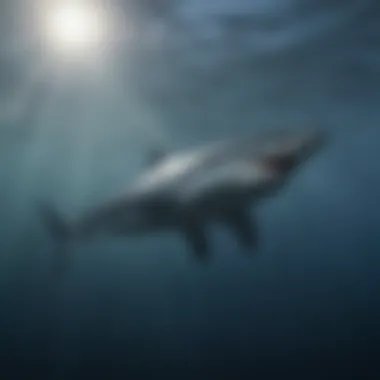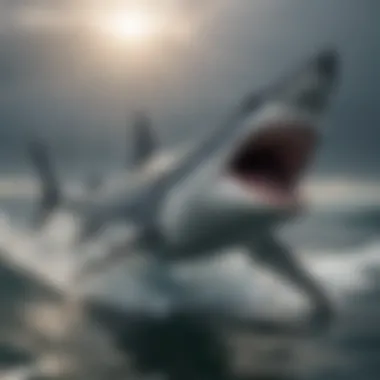Discover the Enigmatic Nature of Mako Sharks with These Fascinating Facts


Rock and Fossil Identification
Mako sharks have a definitive appearance that sets them apart from other shark species. Their streamlined bodies, pointed snouts, and striking coloration make them easily recognizable. When identifying mako shark fossils, it is essential to look for specific characteristics such as well-preserved teeth, vertebrae, and fin spines. These fossil remnants provide valuable insights into the evolutionary history and adaptations of mako sharks. Utilizing tools like magnifying glasses and field guides can aid enthusiasts in accurately identifying and classifying mako shark fossils.
Geological Insights
Exploring the geological context of mako shark habitats reveals a compelling narrative of the relationship between these predators and their surrounding environment. The presence of mako shark fossils in certain rock formations can indicate the past distribution of these species and shed light on their ecological preferences. Studying the geological processes that led to the preservation of mako shark fossils offers valuable information about ancient marine ecosystems and climate conditions. Notable discoveries in paleontological research have deepened our understanding of mako shark evolution and the changing landscapes they inhabited.
Introduction
In this article, we delve into the fascinating world of mako sharks, providing readers with unique and insightful facts about these formidable predators. Mako sharks are known for their speed and agility, making them a captivating subject for exploration. By examining their physical characteristics and behavior, we aim to offer a comprehensive guide to understanding these majestic creatures.
Overview of Mako Sharks
Mako sharks belong to the mackerel shark family, characterized by their streamlined bodies, pointed snouts, and large, toothy grins. These apex predators can be found in tropical and temperate waters worldwide, showcasing adaptability and resilience in various marine environments.
Classification of Mako Sharks
The classification of Mako sharks places them within the Lamnidae family, encompassing other species like the Great White and thresher sharks. This taxonomic categorization highlights the evolutionary relationships and distinct characteristics of these formidable predators, emphasizing their shared ancestry and unique biological adaptations for survival.
Habitat and Distribution
Mako sharks are predominantly pelagic, preferring deep offshore waters where they can pursue their prey with precision and speed. Their distribution ranges from coastal regions to open oceans, with a preference for warmer waters. This broad habitat range underscores their versatility and ability to thrive in diverse marine ecosystems, creating a fascinating subject of study for marine biologists and shark enthusiasts alike.
Physical Attributes
Mako sharks possess remarkable physical attributes that play a pivotal role in their survival and predatory success. From their streamlined body shape to their impeccable coloration and camouflage, every aspect of their physicality is finely tuned for efficient hunting and navigation in the open ocean. Understanding the physical attributes of mako sharks is paramount in unraveling the mysteries of these swift and agile predators, showcasing their evolutionary adaptations and biological prowess.


Distinctive Features
Body Shape
The body shape of mako sharks is a masterpiece of natural engineering, characterized by a sleek, torpedo-like form that enables them to move swiftly through the water with minimal resistance. This hydrodynamic design allows mako sharks to reach impressive speeds and outmaneuver their prey effortlessly. The fusiform body shape is essential for enhancing their agility and cursorial hunting strategy, making them formidable apex predators in their marine environment.
Coloration and Camouflage
The coloration and camouflage of mako sharks serve as crucial adaptations for both hunting and defense. Their metallic blue-gray dorsal surface blends seamlessly with the oceanic backdrop, providing effective camouflage from both prey and potential predators. The countershading pattern, with a lighter underside and darker back, helps mako sharks remain inconspicuous from below and above, granting them a strategic advantage in ambushing prey and evading detection.
Size and Weight
Average Length
The average length of mako sharks plays a significant role in determining their position as top predators within the marine ecosystem. With males typically growing between 6 to 10 feet and females reaching sizes of up to 12 feet or more, mako sharks exhibit a size sexual dimorphism that influences their hunting behaviors and prey selection. Their medium to large body size allows them to target a wide range of marine species, showcasing their versatility as apex predators.
Growth Patterns
The growth patterns of mako sharks reflect their adaptations to varying environmental conditions and resource availability. These sharks exhibit rapid growth rates during early life stages, with juveniles gaining size quickly to reach maturity. The unique growth patterns of mako sharks highlight their resilience and ability to thrive in dynamic oceanic environments, where competition for resources shapes their developmental trajectories.
This article is a comprehensive guide delving into the intriguing world of mako sharks, shedding light on various fascinating facts about these formidable predators.
Behavior and Diet
The topic of behavior and diet plays a crucial role in this article as it uncovers the key elements that govern the survival and predatory tactics of mako sharks. Understanding the behavior and diet of these creatures provides insights into their ecosystem roles, feeding habits, and impact on marine biodiversity.
Predatory Behavior
Hunting Strategies


The hunting strategies employed by mako sharks are critical to their survival and efficiency as predators. With their remarkable speed and agility, mako sharks use ambush tactics and high-speed pursuits to capture their prey. This strategy allows them to capitalize on their quick bursts of energy and sharp teeth to hunt effectively in their marine environment.
Highlighting the key characteristic of hunting strategies showcases the adaptability of mako sharks in targeting various marine species. Discussing the unique feature of hunting strategies emphasizes their versatility in adapting to different prey types. By describing the advantages and disadvantages of these strategies, readers gain a deeper understanding of the hunting prowess of mako sharks in this article.
Prey Preferences
Mako sharks exhibit distinct prey preferences based on their hunting behavior and ecological niche. Understanding their prey preferences is vital in deciphering their role in marine food webs and the balance of oceanic ecosystems. By focusing on specific prey choices, such as fish species or cephalopods, readers gain insights into the dietary requirements and foraging patterns of mako sharks.
Highlighting the key characteristic of prey preferences emphasizes the selective nature of mako sharks in their feeding habits. Describing the unique feature of prey preferences sheds light on the evolutionary adaptations that make them efficient hunters in their habitat. Analyzing the advantages and disadvantages of these preferences provides readers with a comprehensive view of the dietary variances influencing mako shark behavior in this article.
Migration Patterns
Seasonal Movements
The migration patterns of mako sharks reveal crucial information about their reproductive behaviors and foraging strategies. Seasonal movements play a significant role in the distribution and abundance of mako populations across different oceanic regions. By analyzing their seasonal behaviors, researchers can track the movement patterns of mako sharks and understand the environmental factors influencing their habitat preferences.
Highlighting the key characteristic of seasonal movements underscores the cyclical nature of mako shark migrations and their impact on marine ecosystems. Discussing the unique feature of seasonal movements provides insights into the migratory triggers that propel mako sharks to traverse vast distances. Describing the advantages and disadvantages of these movements enhances the reader's comprehension of the challenges faced by mako sharks during their seasonal migrations in this article.
Long-Distance Travel
The long-distance travel undertaken by mako sharks highlights their remarkable endurance and navigational capabilities in the open ocean. Covering extensive distances, mako sharks exhibit unique behaviors during their long-haul journeys, including temperature regulation and energy conservation mechanisms. By exploring these travel patterns, researchers can elucidate the adaptive traits that contribute to the survival of mako sharks in diverse marine environments.
Highlighting the key characteristic of long-distance travel showcases the perseverance and stamina of mako sharks during their transoceanic voyages. Delving into the unique feature of long-distance travel unveils the physiological adaptations that enable mako sharks to thrive during extended migrations. Analyzing the advantages and disadvantages of this travel behavior offers readers a holistic perspective of the challenges faced by mako sharks as they undertake prolonged journeys in this article.
Reproduction and Lifecycle
In this section, we explore the vital significance of Reproduction and Lifecycle in unraveling the mysteries of mako sharks. Understanding the reproductive behavior and life cycle of these creatures provides crucial insights into their survival and evolution. By delving into the intricacies of how mako sharks reproduce and develop, we can gain a deeper appreciation for their role in the marine ecosystem.


Mating Behavior
Reproductive Strategies
Diving into the realm of Reproductive Strategies unveils a fundamental aspect of mako shark behavior. These strategies play a pivotal role in ensuring the sustainability of the species by optimizing successful mating encounters and enhancing genetic diversity. The key characteristic of Reproductive Strategies lies in their adaptive nature, allowing mako sharks to adapt to varying environmental conditions and mating challenges. This adaptability proves to be a vital trait, enabling mako sharks to thrive in diverse marine habitats and secure their reproductive success. Moreover, the unique feature of Reproductive Strategies lies in their ability to minimize reproductive risks and maximize the chances of offspring survival, making them an advantageous choice for exploring the complexities of mako shark reproduction in this article.
Growth and Development
Transitioning to the Growth and Development phase sheds light on the early stages of a mako shark's life cycle. By focusing on Birth and Early Life, we uncover critical insights into the growth patterns, behaviors, and survival mechanisms of juvenile mako sharks. The key characteristic of Birth and Early Life lies in its pivotal role in shaping the future survival and reproductive success of mako sharks. Understanding the challenges and opportunities faced during this developmental stage provides valuable context for appreciating the resilience and adaptive strategies employed by young mako sharks. The unique feature of Birth and Early Life revolves around the delicate balance between growth and vulnerability, underscoring the importance of protective environments and parental care in nurturing the next generation of mako sharks in the vast oceanic expanse of marine life.
Conservation Status
Threats and Challenges
Overfishing
Overfishing poses a significant threat to the conservation status of mako sharks. The excessive and unsustainable harvesting of sharks for their fins, meat, and liver oil has resulted in a severe decline in mako shark populations. The key characteristic of overfishing lies in its indiscriminate nature, where sharks are often caught as bycatch in commercial fisheries targeting other species. This rampant exploitation of mako sharks as a target species for their valuable parts has led to a concerning decrease in their numbers. Addressing the detrimental impacts of overfishing is crucial in ensuring the long-term survival of mako sharks and maintaining the stability of marine ecosystems.
Habitat Loss
Habitat loss poses another significant challenge to the conservation efforts aimed at protecting mako sharks. As highly migratory species, mako sharks rely on diverse habitats throughout their life cycles, including coastal areas for breeding and open ocean for feeding. However, human activities such as coastal development, pollution, and climate change have led to the destruction and degradation of essential shark habitats. The key characteristic of habitat loss stems from the irreversible damage inflicted on critical marine environments that are vital for the survival of mako sharks. Understanding the complex interactions between sharks and their habitats is essential in mitigating the adverse effects of habitat loss and ensuring the continued existence of mako sharks in our oceans.
Conclusion
When delving into the fascinating world of mako sharks, the conclusion proves to be a paramount component in understanding the significance of these remarkable creatures. Throughout this article, the emphasis has been on shedding light on various intriguing facts about mako sharks, from their physical attributes to their hunting habits. The conclusion serves as a culmination of all discussed aspects, summarizing the essence of mako sharks and their importance within the marine ecosystem. By synthesizing the information presented throughout, readers gain a comprehensive understanding of the unique characteristics and behaviors that define these swift and agile predators.
Key Takeaways
Impact of Mako Sharks
Exploring the impact of mako sharks reveals a crucial aspect of their role in the marine environment. These apex predators play a significant part in maintaining the balance of oceanic ecosystems through their predatory behavior, controlling prey populations and ensuring biodiversity. The key characteristic of the impact of mako sharks lies in their top-down regulation of marine food webs, showcasing their importance in marine conservation efforts. Their unique feature as apex predators highlights their influential position in maintaining the health and stability of oceanic ecosystems, despite facing threats such as overfishing and habitat loss. Understanding the impact of mako sharks provides valuable insights into the intricate dynamics of marine ecosystems, emphasizing the need for conservation measures to protect these vital species.
Future Outlook
Considering the future outlook of mako sharks unveils the potential challenges and opportunities that lie ahead for these fascinating creatures. As the oceanic environment continues to face pressures from human activities, the future of mako sharks remains uncertain. The key characteristic of the future outlook is the need for sustainable management practices and conservation efforts to ensure the long-term survival of mako shark populations. Their unique feature as highly migratory species underscores the importance of international cooperation and unified conservation strategies to address the threats they encounter. Despite the challenges posed by overfishing and habitat degradation, the future outlook for mako sharks holds promise through increased awareness, research, and conservation initiatives aimed at protecting these iconic predators for future generations.







